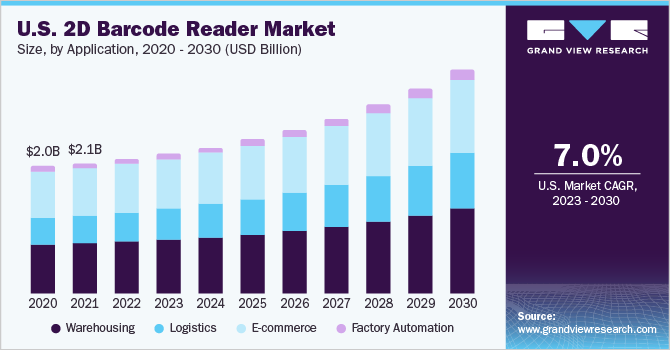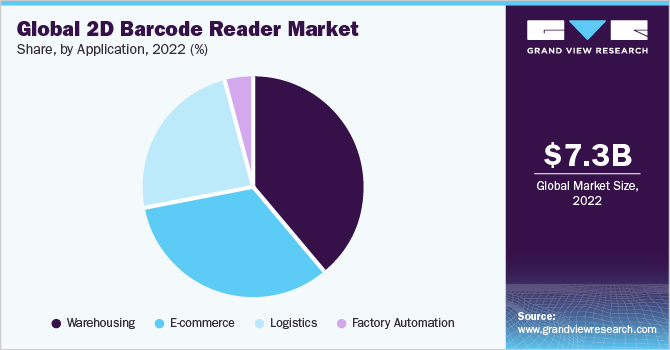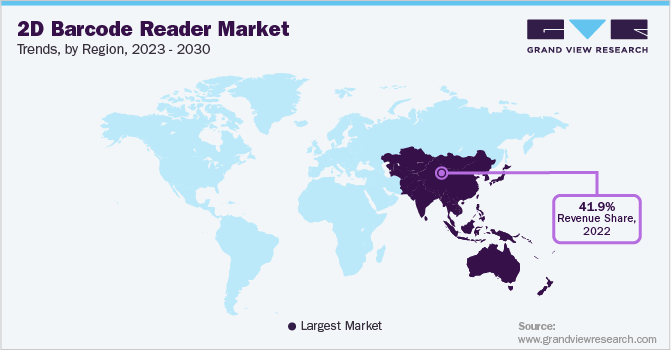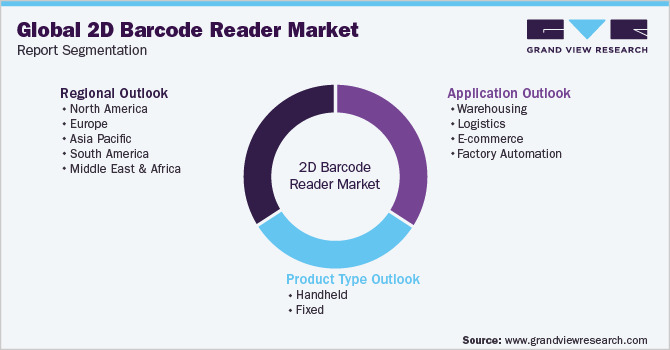- Home
- »
- Sensors & Controls
- »
-
2D Barcode Reader Market Size, Share & Growth Report 2030GVR Report cover
![2D Barcode Reader Market Size, Share & Trends Report]()
2D Barcode Reader Market Size, Share & Trends Analysis Report By Product Type (Fixed, Handheld), By Application (Warehousing, Logistics), By Region (South America, MEA, Asia Pacific), And Segment Forecasts, 2023 - 2030
- Report ID: GVR-3-68038-469-7
- Number of Report Pages: 130
- Format: PDF, Horizon Databook
- Historical Range: 2018 - 2021
- Forecast Period: 2023 - 2030
- Industry: Semiconductors & Electronics
Report Overview
The 2D barcode reader market size was valued at USD 7.32 billion in 2022 and is anticipated to grow at a compound annual growth rate (CAGR) of 8.5% from 2023 to 2030. The market growth can be attributed to the rising e-commerce industry worldwide in line with the evolving developments in the warehousing and logistics industries. Maintaining sales information, ensuring precise timing, and tracking products across the supply chain networks in real-time are becoming of paramount importance to support the robust growth of the online retail industry. The ability to track products in real time has become a core need for online shopping providers. At this juncture, 2D barcode readers are playing a vital role in helping in managing sales information and inventory levels.

Barcodes can reduce data entry errors, which can be costly and difficult to rectify. Barcode scanning can increase accuracy and productivity by minimizing the possibility of human error. It is proved to be a faster and more efficient way to capture data compared to manual methods. Barcodes are capable of providing quicker scanning options, enabling faster checkouts in retail stores, faster tracking & processing of goods in logistics, and faster patient processing in healthcare. When commodities move through the supply chain, barcodes are used to track them, offering businesses more flexibility and control. This can increase efficiency in supply chains by minimizing the possibility of products being stolen or misplaced.
To rapidly and accurately scan product barcodes at the point of sale, barcode readers are widely utilized in retail shops. The rising utilization of these devices in industries, such as healthcare, is also expected to drive market growth. For instance, intensive healthcare facilities in the U.S. are using barcode technology to prevent medication errors. Each patient is given a unique barcode wristband linked to the central computers as part of the process to maintain a unique patient record. Before administering the medication, the nurse scans the wristband and the medication to be administered using a barcode scanner. The data is sent to the central computer where software cross-checks various databases before approving the medication.
In the event of a mismatch, the system issues a warning, thereby preventing any medication errors. These benefits would further supplement the growth of the industry during the forecast period. Advances in wireless technology are further strengthening the transition to digital shopping. While digital shopping is becoming a popular shopping method for consumers worldwide, the integration of wireless technology into barcode scanners is allowing supermarkets and hypermarkets to eliminate long waiting times and accelerate the check-out process. As such, the combination of 2D barcode readers integrated with wireless technology and automated billing systems is adding to the convenience of shopping while ensuring transparent and efficient checkout processes and augmenting consumer satisfaction, thus driving the industry’s growth.
Barcode readers have gained a pivotal role in increasing operational efficiency across various industries and verticals, such as retail, e-commerce, warehousing, and logistics. With advantages, such as higher accuracy and speed, enhanced customer service, and reduced clerical costs, barcode scanning systems are becoming a prominent tool for streamlining internal and external operations. A compact design, adequate flexibility, storage capacity, and real-time tracking of data are some of the additional benefits these devices provide in industrial applications. These factors would further supplement the growth of the overall industry during the forecast period.
Product Type Insights
The handheld segment accounted for the largest revenue share of more than 67.00% in 2022. A handheld device is used for a wide range of applications. For instance, in the manufacturing sector, it acts as a crucial tool for tracking shipping, receiving, and Work-In-Progress (WIP) inventories. In the retail sector, it is used for configuration needs at the checkout counter as it helps in accurate inventory tracking and provides necessary business intelligence for future planning and operational requirements. In the healthcare sector, it is used for correct patient identification, keeping comprehensive electronic medical records management, and medication verification. Furthermore, in the transportation & logistics industry, it enables automation in tracking and recording the shipped, received, picked, packed, and palletized inventories and goods.
The fixed product type segment is anticipated to register the fastest CAGR during the forecast period. Due to the rising demand for speed and accuracy in the tracking of goods and inventories, organizations are continuously moving toward the automation of the industrial process. Fixed devices help reduce the manual effort of employees in collecting, documenting, and scanning large inventories. It helps in offering greater efficiency and accuracy by significantly gathering all necessary information with the maximum possible security. Furthermore, a fixed scanner is an important solution in the retail industry for check-out applications, where an accurate and fast transaction can be ensured for a smooth and hassle-free customer experience in both grocery and non-food retail stores.
Application Insights
The warehouse segment accounted for the largest share of more than 38.70% in 2022. The key operational process in a warehouse requires the moving of bulk inventories, containers, and individual products through a series of unique locations. The collection of manual information for performing inventory counts can be error-prone and time-consuming. 2D barcode reader helps in keeping a record of each rack, container, and item by following a digitized and automated procedure. It provides a unique identification code to inventories and individual goods, which helps in keeping track of transferred and received goods between different locations, within, and outside a warehouse. The logistics segment is expected to register the fastest CAGR during the forecast period.

The use of these devices is growing constantly as they enable quick scanning of barcodes in different shapes, formats, and characters. These devices also improve shipment and delivery procedures by accelerating processes and eliminating manual data entry errors in the logistics industries. For example, parcel shipping companies provide a 2D barcode that is scanned by the 2D barcode reader containing information, such as the destination & address, package weight, information related to the consigner and consignee, and more. This information can be scanned by a 2D barcode reader when the driver picks up and drops off the shipments. Thus, it helps in eliminating the need for recording and verification of information in different stages of delivery procedures.
Regional Insights
The Asia Pacific region accounted for the largest market share of 41.9% in 2022. The growth of 2D barcode reader demand can be attributed to the growing e-commerce, logistics, and warehouse industry in the Asia Pacific regional market. Further, the rising digitization, adoption of 5G, and growing government initiatives towards industry 4.0 for automation and digitization of industries are the key factors driving the demand for 2D barcode readers. With the surge in logistics, manufacturing, and transportation activities across the region, the deployment of automated scanning and reading applications is constantly boosting the demand for 2D barcode readers as it offers seamless operational capabilities, reduces errors, reduces cost, and enhances transparency in the system are the key factors driving the demand for 2D barcode reader market in the Asia Pacific region.

The South America segment is expected to grow at the highest CAGR of 10.2% during the forecast period. The growing proliferation of online shopping and the rising popularity of social media platforms, particularly in countries, such as Brazil, are allowing consumers to purchase and return products at their convenience. These growing trends are driving the demand for automation in manufacturing facilities for better management of inventories and materials in the facilities. The application of 2D barcodes helps businesses in keeping the right track of information related to the product, location, manufacturer, and other related specifications are some of the factors that are expected to create higher growth opportunities for the 2D barcode reader market in the South American region.
Key Companies & Market Share Insights
Key players are investing resources in research & development activities to support growth and enhance their internal business operations. The report will include company analysis based on their financial performances, product benchmarking, key business strategies, and recent strategic alliances. Companies are engaging in mergers & acquisitions and partnerships to further upgrade their products and gain a competitive advantage over other firms.
They are effectively working on new product development, and enhancement of existing products to acquire new customers and capture more industry share. For instance, in January 2023, Cognex Corp. launched the DataMan 580, a fixed-amount barcode scanner, to accelerate operations while enhancing accountability to optimize logistical processes by using edge intelligence, management, and performance solutions to track real-time system performance and improve operations. Some of the prominent players in the global 2D barcode reader market include:
-
Casio Computer Co., Ltd.
-
Cognex Corp.
-
Datalogic S.p.A.
-
Denso Wave Inc.
-
General Data Company, Inc.
-
Honeywell International, Inc.
-
JADAK - A Novanta Company
-
Juniper Systems Inc.
-
Keyence Corp.
-
Marson Technology Co., Ltd.
-
Omron Microscan Systems, Inc.
-
Sato Holdings Corp.
-
Scandit
-
SICK AG
-
Unitech Electronics Co., Ltd.
-
Wasp Barcode Technologies
-
Zebex Industries Inc.
-
Zebra Technologies Corp.
2D Barcode Reader Market Report Scope
Report Attribute
Details
Market size value in 2023
USD 7.69 billion
Revenue forecast in 2030
USD 13.59 billion
Growth rate
CAGR of 8.5% from 2023 to 2030
Base year for estimation
2022
Historical data
2018 - 2021
Forecast period
2023 - 2030
Quantitative units
Revenue in USD million and CAGR from 2023 to 2030
Report coverage
Revenue forecast, company market share, competitive landscape, growth factors, and trends
Segments covered
Product type, application, region
Regional scope
North America; Europe; Asia Pacific; Latin America; MEA
Country scope
U.S.; Canada; U.K.; Germany; France; Italy; Spain; China; Japan; India; Australia; South Korea; Brazil; Argentina; Mexico; UAE; Saudi Arabia; South Africa
Key companies profiled
Casio Computer Co., Ltd.; Cognex Corp.; Datalogic SpA; Denso Wave Inc.; General Data Company, Inc.; Honeywell International, Inc.; JADAK - A Novanta Company; Juniper Systems Inc.; Keyence Corp.; Marson Technology Co., Ltd.; Omron Microscan Systems, Inc.; Sato Holdings Corp.; Scandit; Sick AG; Unitech Electronics Co., Ltd.; Wasp Barcode Technologies; Zebex Industries Inc.; Zebra Technologies Corp.
Customization scope
Free report customization (equivalent up to 8 analysts working days) with purchase. Addition or alteration to country, regional & segment scope
Pricing and purchase options
Avail customized purchase options to meet your exact research needs. Explore purchase options
Global 2D Barcode Reader Market Report Segmentation
This report forecasts revenue growth at global, regional, and country levels and provides an analysis of the latest industry trends in each of the sub-segments from 2018 to 2030. For the purpose of this study, Grand View Research has segmented the global 2D barcode reader market report based on product type, application, and region:

-
Product Type Outlook (Revenue, USD Million, 2018-2030)
-
Handheld
-
Fixed
-
-
Application Outlook (Revenue, USD Million, 2018-2030)
-
Warehousing
-
Logistics
-
E-commerce
-
Factory Automation
-
-
Regional Outlook (Revenue, USD Million, 2018-2030)
-
North America
-
U.S.
-
Canada
-
-
Europe
-
U.K.
-
Germany
-
France
-
Italy
-
Spain
-
-
Asia Pacific
-
China
-
Japan
-
India
-
Australia
-
South Korea
-
-
South America
-
Brazil
-
Argentina
-
Mexico
-
-
MEA
-
UAE
-
Saudi Arabia
-
South Africa
-
-
Frequently Asked Questions About This Report
b. The global 2D barcode reader market size was estimated at USD 7.32 billion in 2022 and is expected to reach USD 7.69 billion in 2023.
b. The global 2D barcode reader market is expected to grow at a compound annual growth rate of 8.5% from 2023 to 2030 to reach USD 13.59 billion by 2030.
b. The Asia Pacific region dominated the market for 2D barcode reader in 2022 and accounted for a global revenue share of over 41.93%. The growth can be attributed to the growing e-commerce and retail industry in the regional market.
b. Some key players operating in the 2D barcode reader market include Cognex Corporation, Denso Wave Incorporated, Datalogic S.p.A., Honeywell International Inc., and Keyence Corporation.
b. Key factors that are driving the 2D barcode reader market growth include reducing error rate and improving operational efficiency, and growth of e-commerce and logistics activities.
b. The handheld product segment dominated the 2D barcode reader market in 2022 and accounted for more than 67.0% of the revenue share.
Share this report with your colleague or friend.
![gvr icn]()
NEED A CUSTOM REPORT?
We can customize every report - free of charge - including purchasing stand-alone sections or country-level reports, as well as offer affordable discounts for start-ups & universities. Contact us now
![Certified Icon]()
We are GDPR and CCPA compliant! Your transaction & personal information is safe and secure. For more details, please read our privacy policy.
We are committed towards customer satisfaction, and quality service.
"The quality of research they have done for us has been excellent."





